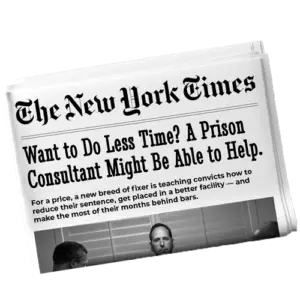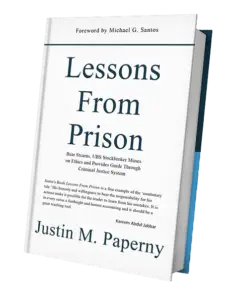Why Do Your 1,000 Minutes Decide Whether You Climb Out of the U—or Stay Stuck at the Bottom?
On April 28, 2008, my mom and older brother, Todd, drove me to the federal prison camp in Taft. Three years to the day earlier, Paul Betrand and another FBI agent had shown up at my front door.
On the way, we stopped at a Carl’s Jr. in Bakersfield, next to a gas station. I ordered everything—Western Bacon, fries, shakes, cookies. I wasn’t hungry, but I ate like I was headed to the electric chair. My family asked if I was ready. I told them I was. I wasn’t.
The truth was I had no plan. My goals were shallow: learn some Spanish, get in better shape, keep my head down, and wait out the year.
Then I met Michael Santos.
The Pull-Ups Conversation In Federal Prison Camp
By the time I got there, Michael had already been in prison more than two decades. While I was exercising all day, he was building: writing, studying, documenting, teaching, publishing, creating.
One afternoon, I bragged to him about running 10 miles and knocking out pull-ups.
“First time I’ve had a six pack since USC,” I said.
He asked, “How much are people going to pay you to do those pull-ups?”
The answer was zero.
Then he added, “You’ve got 1,440 minutes in a day. You’ll sleep about 440. That leaves you 1,000 minutes. What are you doing with them?”
I didn’t have an answer. That was the moment he introduced me to the U-shaped curve.
Preparing For Federal Prison: The U-Shaped Curve
From Lessons from Prison:
“The U-shaped curve measured a man’s path through confinement. As he enters the system, he descends through the U—leaving society behind, full of anxiety. Over time, he adjusts and grows comfortable at the bottom. Exercise, television, and routine fill the days.
But eventually, every man has to ascend the U. The closer he gets to release, the more those anxieties return. Bills, rent, family, work—they’re coming back. The longer someone stays lost at the bottom, the harder the climb out.”
Michael asked me to rate my adjustment. On fitness, I gave myself a ten.
Then he asked, “On preparation for release?”
I admitted: “Probably a one.”
“Bingo,” he said. “People don’t succeed by accident, and they don’t fail by accident. Even in prison, the decisions we make determine the opportunities that open.”
I realized all I’d been thinking about was exercise.
My Pivot In Federal Prison
That was my “aha moment.” I cut workouts from six hours to two. I used the rest of my 1,000 minutes to write. On October 12, 2008, I handwrote my first blog and mailed it to my mom. She typed it and put it online. The next day I wrote again. And again.
Those writings became Lessons from Prison. More importantly, they showed my family I was preparing. They didn’t have to take my word for it. They could see it.
If I had stayed at the bottom of the U, I would have left prison with nothing but problems. I wouldn’t be running this business or supporting Prison Professors Charity, which now influences millions of people. (As I write this, Michael is in D.C. again, meeting with BOP leadership.)
Why This Matters to You If You’re Preparing For Federal Prison
If you’re heading into prison—or you’re already there—you’ll descend into the U like everyone else. The length of your sentence doesn’t matter. The question is whether you’ll stay stuck at the bottom or start climbing.
Your 1,000 minutes each day decide that.
You can drift through prison and panic when release comes, or you can use your time to read with purpose, write, and document progress that shows your family, probation officer, and judge who you are becoming. PrisonProfessors.org gives you the place to do that—create a profile, build a tribe, climb the leaderboard, and share your work with every stakeholder: Earn Your Freedom.
The 1,000 minutes a day Michael invested still pay dividends. Again, Michael is in Washington, D.C., meeting with Bureau of Prisons leadership about expanding earned time credits, furloughs, compassionate release, and work release. That advocacy exists because of the habits he built inside—documenting, creating, using his minutes deliberately.
You have the same choice.
Don’t wait. The 1,000 minutes start today.
Justin Paperny



